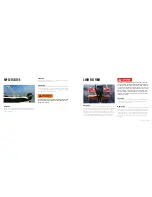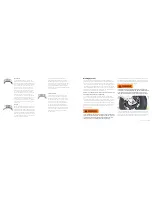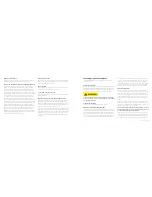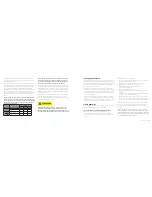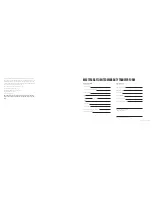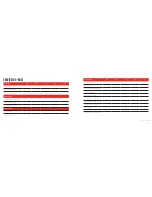
2017 OWNERS MANUAL /
426
According to DOT and OEM requirements, brand new DOT 3
brake fluid must have a dry (no moisture) boiling point of at least
401
o
F/205
o
C, and a wet (moisture saturated) boiling point of no less
than 284
o
F/140
o
C. (Most far exceed these requirements, fresh out of
the bottle.) Older brake fluid (about 18 months) with even three per-
cent (3%) moisture content lowers the boiling point to 293
o
F/145
o
C,
which is dangerously close to the minimum standard requirements.
Water contamination increases the danger of brake failure because
vapor pockets can form if the fluid gets too hot. Vapor displaces flu-
id and is compressible, so when the brakes are applied, the actuator
may completely compress without applying the brakes.
In addition, water laden brake fluid promotes corrosion and pitting
in caliper pistons and bores, wheel cylinders, master cylinders, steel
brake lines and reverse solenoids.
Consumers must use only DOT 3—preferred—or DOT 4 brake fluid. DO
NOT USE DOT 5 BRAKE FLUID. DOT 5 FLUID WILL DAMAGE THE SEALS
IN THE ACTUATOR AND CALIPERS, CAUSING FAILURE OF BRAKES
THAT COULD LEAD TO INJURY OR DEATH. Any other type may not pro-
vide sufficient chemistry to protect against overheating. Brake fluid
should be completely replaced during annual maintenance (at least
once every 12 months or more often if the system has shown evidence
of brake fluid loss). Brake fluid types should never be mixed. Failure
to provide required maintenance can cause brake failure, leading to
incidents that result in serious injury or even death.
Note that the breakaway system is not intended to lock up the trail-
er brakes after separating from the tow vehicle but rather to apply
just enough braking force to keep the trailer from free-wheeling.
The breakaway system must be reset manually after it has been
activated.
DO NOT USE THE BREAKAWAY SYSTEM AS A PARKING BRAKE!
Surface rust may build up on the rotor brake surface if the trailer
isn’t used for a week or more. If this occurs, then generally the brake
pads will wipe off the rust in the first few miles of travel. However, if
the trailer has been idle for several months, or it has been frequent-
ly submerged in salt water and the brakes have not been flushed
out (as described earlier in this section of Owner’s Manual), severe
corrosion can occur.
Try the brakes before each trip. On a regular basis, have the brake
lines inspected, necessary adjustments made and any damaged or
worn parts replaced by an authorized MasterCraft dealer.
Wet brakes usually do not hold especially well. If the wheels have
been in water, several brake applications at slow speeds should
dry them out. If the wheel assemblies have been submerged in salt
water, it is important to flush the rotors and calipers thoroughly with
fresh water to minimize subsequent corrosion.
If the stopping capacity does not meet expectations, have the tow
vehicle and the trailer brakes checked for proper operation. The trail-
er brakes should be inspected by an authorized MasterCraft dealer.
DOT 5 brake fluid is a silicone-based fluid and requires specific
materials for the boots, seals and wipers in the actuator master
cylinder and caliper. Those materials are
NOT
used in MasterCraft
trailers. Regardless of marketing claims made regarding a sup-
posed superiority of DOT 5 brake fluid, the fact is, they will cause
significant failures in the trailer’s brakes because they are not
designed to use DOT 5 brake fluid.
“Unexplained” brake failures are often traced to dragging brakes
caused by the E-stop cable being tripped or the use of DOT 5 brake
fluid. The underlying cause most often is because the brakes got
over-heated and caused the fluid to boil. This can occur when the
fluid level is appropriate, the linings are within specifications, and
the hydraulics appear to work properly.
DO NOT USE DOT 5 brake fluid in any component of MasterCraft
trailers. The silicone causes seals to swell and can bind up caliper
pistons. Do not use this in individual actuators, disc brakes or
solenoids.
The silicone in DOT 5 brake fluid also causes foaming bubbles when
forced through small orifices under high pressure, such as the
solenoid valves in a disc brake system. Bubbles in brake fluid result
in spongy brakes. Silicone also tends to become slightly compress-
ible at temperatures near its boiling point, which makes it generally
inappropriate for trailers used in mountain conditions.
Review the tow vehicle manufacturer’s recommendations and
instructions for towing.
If the brakes are hot, before launching your boat, it is a good idea
to allow the brakes to cool before submerging them. The sudden
change in temperature when submerging very hot calipers and
rotors stresses all the related parts and could cause damage.
If you are unable to back up, check the electronically operated
back-up valve on the actuator, which is connected to the tow vehicle
back up lights. When energized, the valve opens and prevents
pressure build up in the system. When it is energized by shifting the
tow vehicle into reverse, you should hear a noticeable “click” sound.
If you don’t, check that the electrical connection between the tow
vehicle and the trailer is secure.
When parking the trailer, be sure the actuator is fully extended. This
position relieves pressure on the brakes. Corrosion sometimes
causes actuators to freeze in the compressed position. This causes
the brakes to drag and overheat during subsequent outings.
Recommended Brake Fluid
After only a year of use, used brake fluid in the average marine trail-
er may contain as much as two percent (2%) water. Over time, the
percentage will continue to grow and may reach as much as eight
percent (8%). As the concentration of moisture increases, a sharp
drop in the fluid’s boiling point temperature results. As little as one
percent (1%) moisture can lower the boiling point to 369
o
F/187
o
C.
Summary of Contents for NXT20 2017
Page 3: ...2017 OWNERS MANUAL SAFETY KNOWLEDGE ...
Page 27: ...2017 OWNERS MANUAL 48 2017MODEL FEATURESANDSPECS ...
Page 40: ...2017 OWNERS MANUAL 74 DASHESAND VIDEOSCREENS ...
Page 42: ...2017 OWNERS MANUAL 78 XANDXTSERIESINSTRUMENTPANEL 4 3 VIDEOSCREEN XSTARINSTRUMENTPANEL ...
Page 43: ...2017 OWNERS MANUAL 80 PROSTARINSTRUMENTPANEL NXTSERIESINSTRUMENTPANEL ...
Page 58: ...2017 OWNERS MANUAL 110 XANDXTSERIES VIDEOSCREEN OPERATIONSHV450 ...
Page 67: ...2017 OWNERS MANUAL 128 XSTAR VIDEOSCREEN OPERATIONS XSTARINSTRUMENTPANEL ...
Page 80: ...2017 OWNERS MANUAL 154 PROSTAR VIDEOSCREEN OPERATIONS ...
Page 97: ...2017 OWNERS MANUAL 188 NXT OPERATIONS ...
Page 101: ...2017 OWNERS MANUAL 196 NXT20 22 VIDEOSCREEN OPERATIONS ...
Page 107: ...2017 OWNERS MANUAL 208 BOAT OPERATIONS ...
Page 158: ...2017 OWNERS MANUAL 310 PREPARATION ...
Page 172: ...2017 OWNERS MANUAL 338 CAREAND MAINTENANCE ...
Page 204: ...2017 OWNERS MANUAL 402 TRAILERS ...

